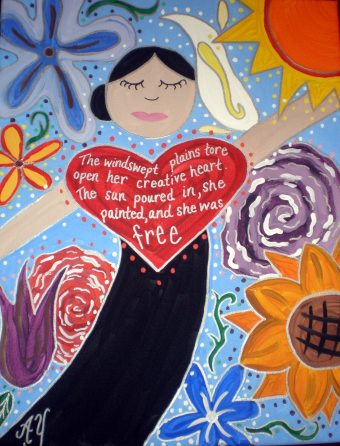Hailed as the Mother of American Modernism, her seemingly vaginal flowers lauded by feminists and artists alike, Georgia O’Keeffe stands as a sentinel for strong, creative women who balk at tradition and embrace a faraway freedom. Though she adamantly denied any association with female genitalia embedded in her sensuously up-close-and-personal flowers—even from feminist artists as famed as Judy Chicago—she remained a female force unbound, painting, living, loving, and creating on her own terms. So, it’s no wonder that she joins my Holy Woman Icons with a folk feminist twist: Virginia Woolf , the Shulamite, Mary Daly, Baby Suggs, Pachamama and Gaia, Frida Kahlo, Salome, Guadalupe and Mary, Fatima, Sojourner Truth, Saraswati, Jarena Lee, Isadora Duncan, Miriam, and Lilith.
Born in November 1887, O’Keeffe knew she would be an artist from the young age of seven. Whether you’re familiar with her intricate flowers, soaring skyscrapers, or desert skulls depends largely on the period of her life that interests you. Whether it was the rural Wisconsin farm of her childhood, the bustling city of New York where she began her relationship with famed photographer Alfred Stieglitz, the peaceful lake in the Adirondack Mountains where they summered, or the harsh desert landscapes of New Mexico where she devoted her later years, she found inspiration and captured beauty wherever she lived, camped, traveled, hiked, or drove in her Ford Model A.
During her tumultuous relationship with Stieglitz, he photographed her hands, face, and naked body in such a way that made her person a recognizable icon just as much as the irises, ladders to the moon, and vast desert landscapes she painted so thoughtfully. Stieglitz may be partially responsible for her professional entre into the art world because he was the first to display her work—charcoal drawings—in his famous avant-garde gallery 291. She illustrated her staunch independence when she challenged her lover for showing her work without her official permission. From that moment on, she flourished as an artist who captured the feeling of a place more so than merely copying the place’s image. Perhaps this is why countless other feminists have found inspiration and empowerment in her flowers, claiming that they embody the essence of woman. Fueling these feminists claims was also the fact that O’Keeffe often traveled to New Mexico with a female friend where the two hiked, camped, stripped naked in the Southwestern sun, and were rumored to have a lover’s tryst in the faraway desert land. Needless to say, Stieglitz remained in New York or the Adirondacks during these journeys.
When Stieglitz (who was 23 years her senior) passed away, O’Keeffe made New Mexico her permanent home, gathering stones, skulls, and flowers and shaping them into architectural still life paintings silhouetted against the expansive blue skyline. She was viewed as a fierce individualist who savored solitude and painted on her own in a time when women were expected to devote their lives to a man and his work. Clad in long black dresses, dark men’s shoes, and her hair tied back into a tight bun, she appeared almost monk-like against the deep red rocks and sandy plains of the New Mexico backdrop. In her solitary attire, she braved the wild desert—the “faraway” as she called it—claiming, “I’ve been absolutely terrified every moment of my life—and I’ve never let it keep me from doing a single thing I wanted to do.”
 It was in this deserted landscape where she found true freedom, her heart ripped open so that the sun could shine in, filling her life and her art with light, hope, and a deep sense of adventure. So, surrounded by the flowers that made her famous and the crystal blue sky that set her free, the sun shines on Georgia O’Keeffe, as her heart cries out to us:
It was in this deserted landscape where she found true freedom, her heart ripped open so that the sun could shine in, filling her life and her art with light, hope, and a deep sense of adventure. So, surrounded by the flowers that made her famous and the crystal blue sky that set her free, the sun shines on Georgia O’Keeffe, as her heart cries out to us:
The windswept plains tore
Open her creative heart.
The sun poured in,
She painted,
And she was free.
Whenever I find myself afraid of the “faraway” that lies beyond my vision, or concerned about what society says women should be and do, I think of Georgia O’Keeffe. Unbound, and with her eyes open to both the expanse and intricacies of the natural world, she emboldens me to take the next step and discover the freedom found in faraway beauty.
Rev. Dr. Angela Yarber has a PhD in Art and Religion from the Graduate Theological Union at UC Berkeley and is author of Embodying the Feminine in the Dances of the World’s Religions, The Gendered Pulpit: Sex, Body, and Desire in Preaching and Worship and Dance in Scripture: How Biblical Dancers can Revolutionize Worship Today. She has been a clergywoman and professional dancer and artist since 1999. For more on her research, ministry, dance, or to purchase one of her icons, visit: www.angelayarber.com



I didnt realize that about Georgia O’keeffe… thank you for this post, I learn so much from your blog! :)
LikeLike
Thanks for this post, and your gift of finding and sharing the most profound beauty in the souls of creative people. She seems one of the most adaptable of painters, as you say, beautifully threading her artistic journey. Everything is alive to O’Keeffe, an orchid, the desert, a street lamp, a kachina doll, the skyscraper!!
LikeLike
Once when I had an office in a fancy building, I put up a print of one of Georgia O’Keefe’s very sensual flowers. And I was told to take it down. It is an amazing talent, an amazing spirit, that can evoke such feeling from one simple, very sensual flower. Thank you for enlightening me more about this wonderfully gifted woman.
LikeLike